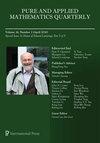斐波那契多项式
IF 0.8
4区 数学
Q3 MATHEMATICS
引用次数: 0
摘要
斐波那契多项式 ${lbrace F_n (x) \rbrace}_{n \geq 0}$ 已经被用多种方法研究过了,[$\href{https://www.imsc.res.in/~viennot/wa_files/viennotop1983-ocr.pdf}{1}$,$\href{https://www.fq.math.ca/Scanned/11-3/hoggatt1.pdf}{6}$,$\href{https://www.fq.math.ca/Scanned/12-2/hoggatt1.pdf}{7}$,$\href{https://www.rivmat.unipr.it/fulltext/1995-4/1995-4-15.pdf}{9}$]。在本文中,我们通过 Viennot 的堆理论[11, 12]来研究它们。在这种情况下,我们的多项式构成了一个 ${lbrace P_n (x) \rbrace}_{n \geq 0}$ 的基础,其中 $P_n (x)$ 是阶数 $n$ 的单项式。鉴于此,我们不得不设置 $P_n (x) = F_{n+1} (x)$。堆的设置扩展了三项递归给出的正交多项式经典理论的弗拉约莱特观点 [3, 10]。因此,有了堆,多项式 $P_n (x)$'s 的大多数等式都可以通过组合论证推导出来。利用目前的设置,我们可以推导出各种新的等价性。我们必须指出,这里提出的堆理论没有任何限制。这远远超出了处理斐波那契多项式的需要。我们这样做是为了传达堆的力量。在$\href{https://link.springer.com/book/10.1007/978-3-030-58373-6 }{[5]}$中有一章专门讨论堆,其中大部分内容都是关于堆理论的应用。本文在$\href{https://link.springer.com/book/10.1007/978-3-030-58373-6 }{[5]}$中的发展基础上加以改进,增加了其中省略的细节。本文章由计算机程序翻译,如有差异,请以英文原文为准。
Fibonacci polynomials
The Fibonacci polynomials ${\lbrace F_n (x) \rbrace}_{n \geq 0}$ have been studied in multiple ways, [$\href{https://www.imsc.res.in/~viennot/wa_files/viennotop1983-ocr.pdf}{1}$,$\href{https://www.fq.math.ca/Scanned/11-3/hoggatt1.pdf}{6}$,$\href{https://www.fq.math.ca/Scanned/12-2/hoggatt1.pdf}{7}$,$\href{https://www.rivmat.unipr.it/fulltext/1995-4/1995-4-15.pdf}{9}$].In this paper we study them by means of the theory of heaps of Viennot [11, 12]. In this setting our polynomials form a basis ${\lbrace P_n (x) \rbrace}_{n \geq 0}$ with $P_n (x)$ monic of degree $n$. This given, we are forced to set $P_n (x) = F_{n+1} (x)$. The heaps setting extends the Flajolet view$\href{https://doi.org/10.1016/0012-365X(80)90050-3}{[4]}$ of the classical theory of orthogonal polynomials given by a three term recursion [3, 10]. Thus with heaps most of the identities for the polynomials $P_n (x)$’s can be derived by combinatorial arguments. Using the present setting we derive a variety of new identities. We must mention that the theory of heaps is presented here without restrictions. This is much more than needed to deal with the Fibonacci polynomials. We do this to convey a flavor of the power of heaps. In $\href{https://link.springer.com/book/10.1007/978-3-030-58373-6 }{[5]}$ there is a chapter dedicated to heaps where most of its contents are dedicated to applications of the theory. In this paper we improve upon the developments in $\href{https://link.springer.com/book/10.1007/978-3-030-58373-6 }{[5]}$ by adding details that were omitted there.
求助全文
通过发布文献求助,成功后即可免费获取论文全文。
去求助
来源期刊
CiteScore
0.90
自引率
0.00%
发文量
30
审稿时长
>12 weeks
期刊介绍:
Publishes high-quality, original papers on all fields of mathematics. To facilitate fruitful interchanges between mathematicians from different regions and specialties, and to effectively disseminate new breakthroughs in mathematics, the journal welcomes well-written submissions from all significant areas of mathematics. The editors are committed to promoting the highest quality of mathematical scholarship.

 求助内容:
求助内容: 应助结果提醒方式:
应助结果提醒方式:


